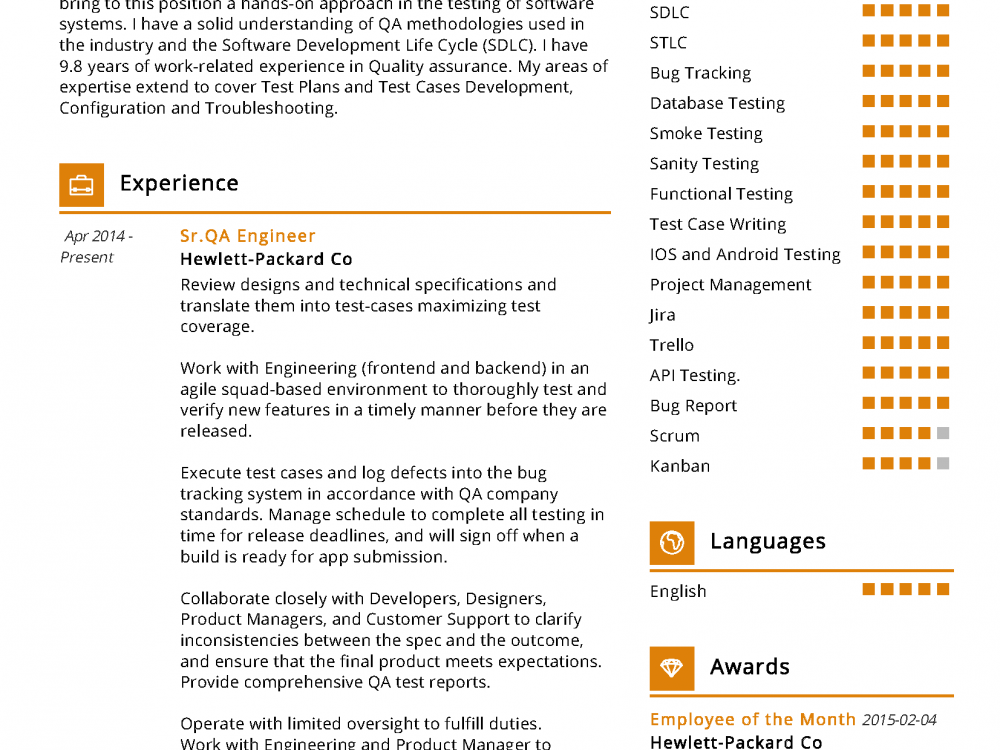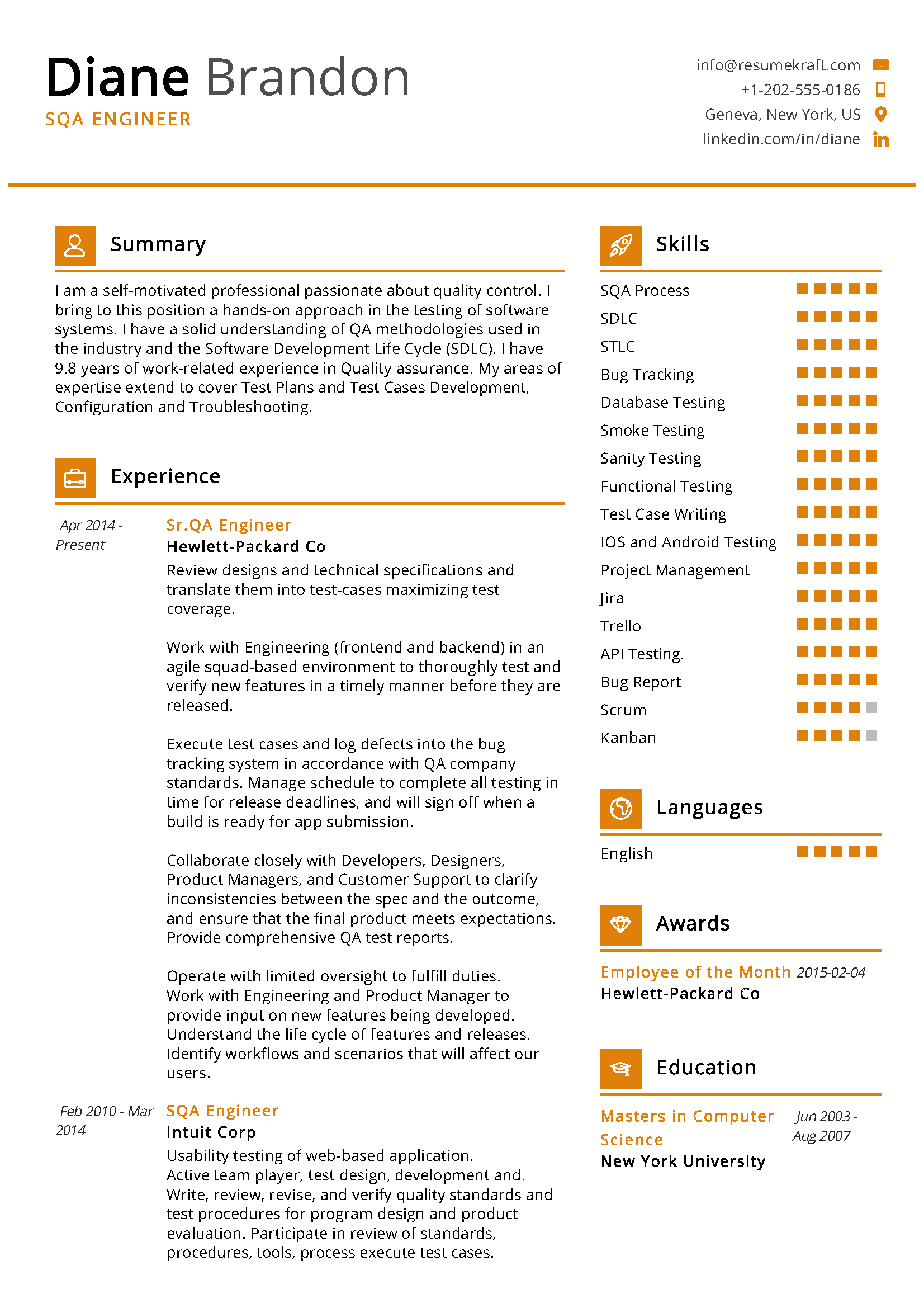SQA Engineer Resume with Writing Guide
Many students and professionals dream of working in Silicon Valley. However, most people don’t know what it takes to land an interview. Here’s a guide that will show you how to write and tailor your resume for jobs in Silicon Valley. Follow these steps to land interviews on sites like Facebook, Google, Apple, Twitter, Microsoft, etc.
SQA Engineer Resume Writing Guide:
1. Don’t Lie
Interviewers are typically nice people, like the one who may or may not remember that you’re applying there. They are usually not going to know that you lied on your resume. But, writing poor resumes is like wearing elephant shoes: it can only make you look bad in the long run. So be honest with your resume and actually show that you have experience in a certain area.
2. Employers don’t care about your past experience
Don’t try to impress employers with your past experience. In fact, employers don’t want to know about your past experience at all. They only care about what you can do for them. However, they do want to see that you’re capable of doing the job in front of them. So be honest with the work you’ve done and focus on how much you’ve learned from that experience and how that has made you more skilled in the job at hand now.
3. Make it Personal
Don’t write a resume for yourself. Write it for the person who is going to be reading your resume (or hirer if you’re in HR). That person would be looking at each bullet point and trying to figure out which one you mean, so make sure it’s clear. Sometimes, a part of your resume can read as if you’re trying to convince them that you’re the right person for the job. When you’re just writing for yourself, it reads more like you’re trying to make yourself look better than you really are.
4. Stick to the Point
Always make sure that your resume only addresses the position for which you are applying. Potential employers love to see that you’ve done your research and understand exactly what they need. But make sure you’re not wasting their time. If they don’t even need another developer, it’s not going to be a good fit for them. So don’t waste their time and money if they’re not interested in hiring you.
5. Include References
Many students and professionals think that including references in their resumes is not necessary, but it’s always better to include one or two just in case there are any questions about the person.
SQA Engineer Responsibilities:
- Maintain the existing software solution to ensure that it meets the customer’s business needs
- Solve problems that may occur during installation, upgrade, or use of computer hardware or software and recommend solutions for improving the system as needed
- Coordinate with technical support staff and service engineers to correct any problems in a timely manner.
- Analyze users’ needs and make recommendations for system enhancements or upgrades
- Make recommendations regarding the purchase of computer hardware and software
- Provide recommendations for hiring additional personnel
- Provide input on software development and system design
- Coordinate with other teams to ensure that the project goals are met
- Use technical knowledge to solve problems
Top 15 SQA Engineer Skills:
- Examine the system to determine the software that will solve a customer’s current problems
- Determine whether additional hardware will be needed and constantly monitor the system usage in order to recommend changes and purchases of additional hardware as necessary
- Analyze requirements to determine whether or not a new system configuration may be necessary
- Identify and resolve problems associated with computer systems software configurations, upgrades, or operating systems upgrades
- Recommend changes or improvements to software configurations related to user needs, performance, cost, reliability, etc.
- Examine the system to determine if there are problems associated with hardware or software in order to determine the cause of the problems.
- Evaluate customer requirements and recommendations to determine whether a new system configuration may be necessary to fix operational problems.
- Research new hardware and software products that meet customer needs and recommend appropriate purchases
- Analyze users’ needs and make recommendations for system enhancements or upgrades
- Design the computer systems, including user interfaces, operating systems, etc., on which software is executed
- Determine the proper hardware for system configurations and recommend purchases
- Design user-friendly computer interfaces
- Suggest improvements, such as operating system configuration changes or upgrades that will improve system performance
- Evaluate new hardware and software products to determine if they meet customer needs
SQA Engineer Resume Objective:
Resumes can be the difference between getting an interview and not. So, make sure your resume will get you noticed. Then, sit down and write your resume for a small Silicon Valley company. Note: Your resume should reflect your background, but it shouldn’t exactly be copy-pasted from a job description either.
Tips:
- If you have a lot of experience, make a bulleted list of your accomplishments in bullet points.
- If you don’t have a lot of experience, list the specific projects that you worked on and how long you were there.
- List every technical skill that you performed, even if it is not directly related to the job given.
- Make sure to highlight everything related to the job.
- Under your experience, include a list of every project that you worked on and whether or not you completed it.
SQA Engineer Resume Objective Example:
“My name is John. I was born in the San Francisco Bay Area and have lived there most of my life. I attended the University of California, Davis in order to earn a degree in computer science. During my time at college, I focused on programming and spent a lot of time-solving problems for professors and other students. After graduation, I began working for Intel Corporation at a position where I was tasked with running diagnostics on their high-end server computers using Perfmon.”
SQA Engineer Cover Letter:
In your cover letter, you can incorporate a lot of the things that you included in your resume. For example, if you do include a list of every project that you worked on and whether or not you completed it, use it in your cover letter. When writing your cover letter, think about the company and how what they do aligns with what you are looking for. For example, if you’re interested in the company because they’re constantly deploying new technical systems and that’s what you want to do with your life, bring it up.
Types of Testing:
There are several different types of testing that software engineers must be familiar with.
These include Acceptance Testing and Performance Testing. Acceptance testing is used to determine whether a particular product meets the criteria of an organization or client. It is focused on the business requirements but also covers functional requirements.
Tips:
- Don’t include everything from your resume in the first sentence.
- Keep your cover letter short.
- Include keywords from the job description to show that you have done research on the company and what they do.
- Tell a short story about yourself that relates to the job and company and how you connect to it.
- Use action verbs like “analyze”, “recommend”, “solve”, “design”, and “integrate”.
- Focus on the job and company, and don’t repeat your resume.
- Keep your letter professional and not too informal or too personal.
- Make sure that you proofread it twice before sending it, so make sure that you have as little typos as possible.
Key Takeaways:
- Making a career change isn’t easy and takes a lot of time and effort, so be sure that this is what you want.
- If you are in the tech world, don’t be afraid to jump between companies. You should always strive to learn new skills.
- Do research on the company before applying for jobs. This will make your application stand out from the crowd.
- Don’t just send in a generic cover letter with your resume.


